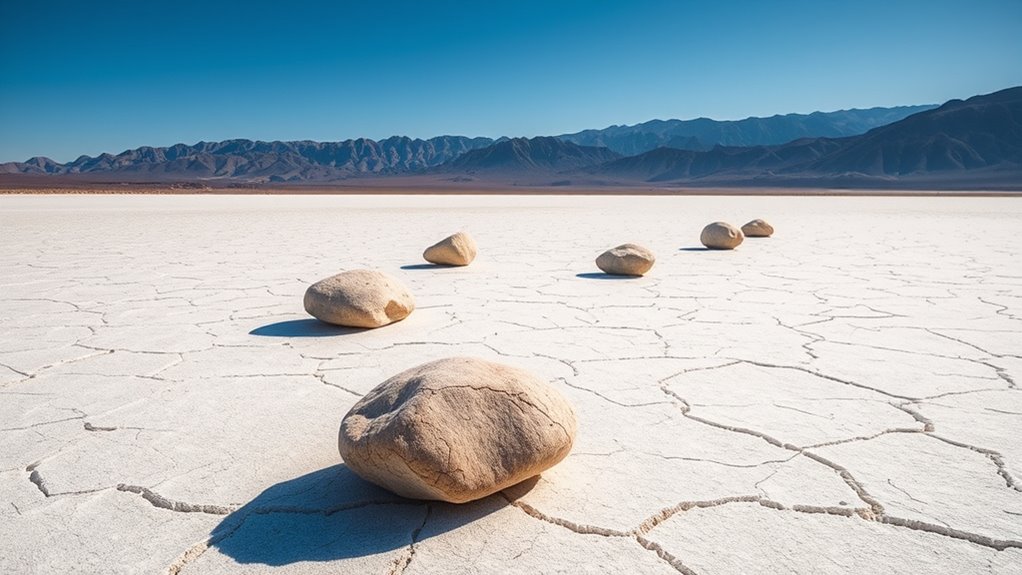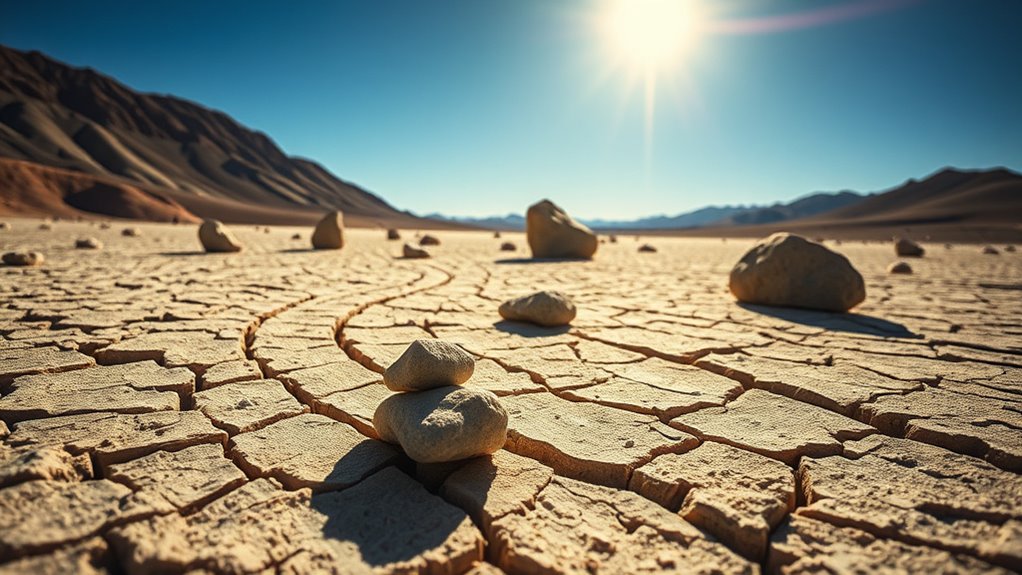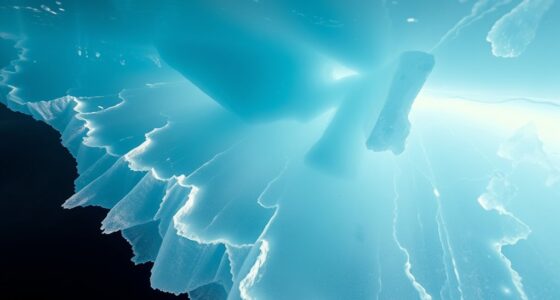The sailing stones of Death Valley move slowly across flat, dry surfaces due to a natural process involving rare rainfalls, freezing temperatures, and wind. When water collects and then evaporates, it leaves behind a thin ice layer that acts as a lubricant. Wind or vibrations then cause the stones to glide, leaving trails over years or decades. If you stay curious, you’ll discover how these incredible natural factors come together to create this mysterious phenomenon.
Key Takeaways
- Sailing stones are a natural phenomenon in Death Valley where rocks move and leave trails without human or animal intervention.
- Movement occurs during rare rainfalls when a thin ice layer reduces friction, allowing stones to slide.
- Wind and slight vibrations trigger the stones’ slow movement across flat, smooth, clay-rich surfaces.
- Erosion shapes the terrain, creating ideal conditions like slick, icy crusts for the stones to glide.
- The process is slow, taking years or decades, driven by environmental factors like water, temperature, and wind cycles.

The sailing stones of Death Valley are a fascinating natural phenomenon that has puzzled scientists for decades. You might have heard about these mysterious rocks that seem to move across the desert floor on their own, leaving long trails behind them. To understand how this happens, you need to consider the unique rock formation and the process of desert erosion that creates the perfect environment for these stones to “sail.” It’s not magic or supernatural forces at work but a combination of natural factors working together over time.
First, let’s look at how the landscape and rock formation set the stage for this phenomenon. The area where the sailing stones are found is characterized by flat, dry, and often smooth clay-rich surfaces. These surfaces form a slick, somewhat icy-looking crust when wet, which is essential for the stones to move. During rare rainfalls, the desert transforms temporarily, and water collects on the surface. As the water begins to evaporate, it leaves behind a thin, fragile sheet of ice. This ice acts as a natural lubricant, reducing friction between the rock and the ground. When wind or slight vibrations occur, the rocks can then slide over the slick surface, carving out their distinctive trails.
The flat, clay-rich surfaces create a slick, icy crust that enables stones to glide and leave trails.
Desert erosion plays a critical role in shaping the environment that allows this to happen. Over centuries, wind and occasional water flows erode and smooth the terrain, creating the flat, expansive surfaces necessary for the stones to move freely. The erosion process also helps form the thin, icy crust that forms during rare rain events. Without this erosional shaping, the terrain would be too uneven or rough, preventing the stones from gliding effortlessly. The desert’s natural cycle of wetting, freezing, and drying, combined with the landscape’s erosion, creates a perfect storm for these stones to sail across the surface.
You might wonder why these stones don’t move all the time. It’s because the conditions required are incredibly specific and rare. Only during certain weather patterns—when rain falls, temperatures drop enough for ice to form, and wind stirs—do these stones start their slow journey. When the conditions align, the stones can move several meters, leaving behind a trail that hints at their mysterious voyage. The process is painstakingly slow, taking years or even decades for each movement, making it a truly remarkable example of nature’s subtle power.
In essence, the sailing stones are a tribute to how natural processes like desert erosion and unique rock formations combine to produce a captivating spectacle. You’re witnessing the slow, deliberate dance of stones, guided by the environment’s natural forces, a reminder of Earth’s quiet, persistent artistry. Recognizing the role of natural cycles in this phenomenon helps us appreciate the intricate balance of environmental factors that make such rare events possible.
Frequently Asked Questions
How Long Does It Take for a Stone to Move Across the Desert?
You might wonder how long it takes for a rock to move across the desert. Rock movement in desert dynamics varies, depending on factors like wind, rain, and ice. Sometimes, stones move only a few inches per year, while in rare conditions, they can travel several yards over decades. You’ll notice that the motion is slow, but persistent, revealing how natural forces gradually shape the landscape over time.
Are the Stones Ever Displaced by Animals or Humans?
You might wonder if animals or humans ever displace the sailing stones. While animal interference and human impact are possible, they’re extremely rare and usually minimal. The stones are mostly moved by natural causes like wind and ice. People generally avoid disturbing these formations, so human impact is limited. Overall, the stones stay pretty much where nature intended, with only natural forces causing their slow, deliberate movement across the desert floor.
Can the Phenomenon Occur in Other Desert Regions Worldwide?
Did you know that only a handful of desert regions worldwide display sailing stones? While these phenomena are mostly linked to Death Valley’s unique conditions, some similar occurrences happen in other deserts like Utah’s Great Salt Lake Desert. However, each site’s regional uniqueness, including specific climate and geology, influences whether the stones move. So, while possible elsewhere, the phenomenon’s exact mechanics are mostly limited to certain environments.
What Is the Exact Chemical Composition of the Stones?
You ask about the chemical composition of the stones. Through chemical analysis, scientists find that the mineral composition mainly includes dolomite, clay minerals, and other sediments. These minerals give the stones their unique characteristics. While the exact composition varies slightly, understanding their mineral makeup helps explain how they move. This detailed chemical analysis reveals the stones’ natural origins and the processes that influence their behavior in deserts like Death Valley.
How Do Scientists Predict the Stones’ Movement Patterns?
Imagine the stones whisper their secrets; scientists listen with keen eyes and minds. You’re interested in how they predict the stones’ dance across the valley floor. Using rock slide mechanisms and predictive modeling techniques, researchers track weather patterns, wind, and slope dynamics. They analyze these factors to forecast movement, like reading a map of an unseen journey. This method helps reveal the stones’ mysterious, slow-motion ballet across Death Valley’s desert stage.
Conclusion
Now that you understand how the sailing stones move, you can picture them gliding silently across Death Valley’s dry floor, like specters from a bygone era. The combination of ice, wind, and mud creates a natural ballet, reminding you that even in the most desolate places, nature’s secrets unfold in mysterious, almost magical ways. Just as a Victorian explorer might have marveled at this marvel, you now hold the knowledge to truly appreciate this enigmatic dance.









